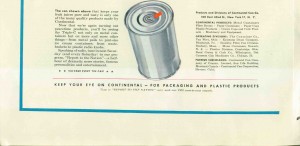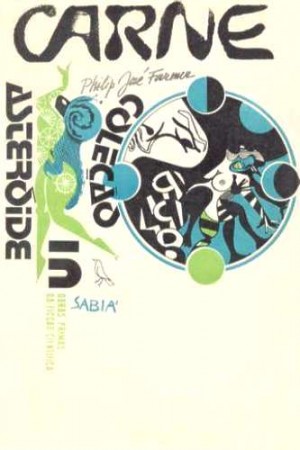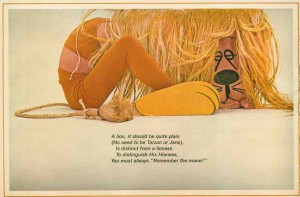Books
The Weirdest Tattoos
This is surely a book that will appeal to the WU crowd. A compilation of the worst tats ever inked. If this sample is representative, we're in for a treat.
Posted By: Paul - Wed Aug 20, 2008 -
Comments (16)
Category: Body Modifications, Tattoos, Stupidity, Books
Follies of the Mad Men #13
[From Fortune for December 1945. Two scans, top and bottom.]
There is nothing spectacularly "weird" about this particular entry in our series, except that the artist is William Steig, the famed illustrator and author responsible, most notably in Hollywood terms, for Shrek. It's curious to see him turning his talents to advertising during his early career, as so many artists who later grew rich and famous once did.
Perhaps the true vestige of weirdness here, though, is the image of the proud boy wearing his Jughead cap. You can learn about the history of the Jughead beanie and how to make such a cap yourself at Juggie's Wikipedia page. Or perhaps you'd want to buy one readymade, either here or here.
But maybe you want to go for the entire Jughead look!
Posted By: Paul - Sun Aug 17, 2008 -
Comments (2)
Category: Business, Advertising, Products, Fashion, Hollywood, Literature, Books, Fantasy, Movies, Comics, 1940s
13 Things That Don’t Make Sense
Posted By: Paul - Sun Aug 10, 2008 -
Comments (3)
Category: Science, Technology, Unsolved Mysteries, Books
Eugênio Hirsch
Discovering traces of a forgotten surrealist/pop artist is always nice and weird. That's why I'm happy to present here some data on Eugênio Hirsch--a name I believe will be little-known to English-speaking art-lovers.I took the liberty of having Google translate his Spanish Wikipedia entry, and then cleaned up the text a bit.
Eugênio Hirsch (Vienna, 1923 - Rio de Janeiro, September 23 2001) was a visual artist of Austrian origin, considered one of the pioneers of Brazilian graphic design.
Eugênio Hirsch was born in Vienna, Austria in 1923. Given the imminence of World War II his family emigrated in 1938 to Argentina, where Hirsch was highlighted as a graphic artist. During his stay in Argentina, he lived in Buenos Aires where he worked for the Encyclopedia Codex. In 1947 he met Monteiro Lobato, who illustrated texts mentioned in the editorial. He also lived in San Miguel de Tucuman where he worked with Lino Spilimbergo Enea.
In 1955 he emigrated to Brazil. Beginning in 1960 he was hired by the publisher "Civilização Brasileira" and in a short time revolutionized the concept and design of book covers, becoming one of the biggest names in this specialty. In 1960 he won the Jabuti Award (highest distinction in the field Brazilian literary and artistic). He was considered a pioneer of graphic design with decisive influence on subsequent generations. One of his favorite quote was "Uma feita layer is to attack, did not to please" ( "A cap is used to attack, not to please"). In 1965 he traveled to the United States where he collaborated with Playboy magazine and then to Europe, but then returned to his adoptive country, Brazil.
Among his most famous works include the illustration done for the novel Lolita by Vladimir Nabokov. He was also recalled for his eccentric personality.
Eugênio Hirsch died in Rio de Janeiro on September 23, 2001.
You can see some of his book covers on this Flickr page. But my favorite is this one he did for the novel Flesh by the great Philip Jose Farmer.
How did I chance upon Hirsch's work? Through this pictorial in Playboy for December 1965. The mildly NSFW totality of the feature is to be found after the jump.
More in extended >>
Posted By: Paul - Sun Aug 10, 2008 -
Comments (4)
Category: Art, Pop Art, Surrealism, History, Historical Figure, Literature, Books, Science Fiction, Magazines, Sexuality, Sex Symbols, World, Europe, South America
Invest in Literature—and a Piece of the Brooklyn Bridge
Do you have a spare $2000.00 lying around the house? Why not send it to this untested fiction writer and receive a share of his entirely hypothetical profits?In fact, I'm a relatively penniless writer too!
Thanks to good pal Sandy Pearlman for discovering this one!
Posted By: Paul - Fri Aug 08, 2008 -
Comments (4)
Category: Frauds, Cons and Scams, Literature, Books, Writers, Money, Charity, Self-help Schemes, Performance Art
Bizzare Experiments

But eagle-eyed reader Rowenna noticed that, on the cover, the word "bizarre" was misspelled. They spelled it "bizzare". Panicked, I ran to check if the actual cover had the same misspelling. (By coincidence, I had just received my copy of the UK edition in the mail.) Thankfully, it was spelled correctly. But then I noticed that the same misspelling occurs on the cover photo on Amazon. I'll have to let my publisher know. I don't think "bizzare" is an alternative UK spelling of "bizarre".
Posted By: Alex - Thu Aug 07, 2008 -
Comments (1)
Category: Science, Experiments, Books, Alex
Perfectible Worlds
A new book titled Perfectible Worlds by the photographer Sage Sohier, devoted to people who amass oddball collections, seems a winning item for all readers of WEIRD UNIVERSE.[Photo copyright by Sage Sohier.]
Posted By: Paul - Sat Aug 02, 2008 -
Comments (0)
Category: Eccentrics, Collectors, Geeks, Nerds and Pointdexters, Photography and Photographers, Books, Roleplayers and Re-enactors
Robotic Writing Monk
The relentless march of progress continues. Now monks have been automated, thanks to The Bible Scribe.Start looking for a new job, Brother.

Posted By: Alex - Wed Jul 23, 2008 -
Comments (0)
Category: Art, Religion, Technology, AI, Robots and Other Automatons, Books
Art Garfunkel’s Library
Art Garfunkel has kept a record of every book he's read since 1968. If you want, you can download the entire list. Yes, this is THE Art Garfunkel, of Simon and Garfunkel.The guy has read an impressive amount, but I don't find it to be a particularly interesting selection. The bulk of it is stuff you might find in a college literature course (i.e. "The Classics"). There isn't much of what gets labeled as genre literature, such as science fiction or horror. Personally, I think some of the most imaginative literature gets produced in those genres.
Garfunkel's list is also relatively light on non-fiction academic works from the sciences and social sciences. I guess the problem is there are just too many interesting books. No one has time to read them all. (via Reality Carnival)
Posted By: Alex - Sun Jul 13, 2008 -
Comments (0)
Category: Literature, Books, Music
The Old Leather Man
I'm eager to read The Old Leather Man when it appears in October from Wesleyan University Press. It sounds like prime historical weirdo material."In 1883, wearing a sixty-pound suit sewn from leather boot-tops, a wanderer known only as the Leather Man began to walk a 365 mile loop between the Connecticut and Hudson Rivers that he would complete every 34 days, for almost six years. His circuit took him through at least 41 towns in southwestern Connecticut and southeastern New York, sleeping in caves, accepting food from townspeople, and speaking only in grunts and gestures along the way. What remains of the mysterious Leather Man today are the news clippings and photographs taken by the first-hand witnesses of this captivating individual. The Old Leather Man gathers the best of the early newspaper accounts of the Leather Man, and includes maps of his route, historic photographs of his shelters, the houses he was known to stop at along his way, and of the Leather Man himself. This history tracks the footsteps of the Leather Man and unravels the myths surrounding the man who made Connecticut’s caves his home."
Posted By: Paul - Wed Jul 09, 2008 -
Comments (1)
Category: Eccentrics, Hermits, History, Historical Figure, Regionalism, Travel, Books

| Who We Are |
|---|
| Alex Boese Alex is the creator and curator of the Museum of Hoaxes. He's also the author of various weird, non-fiction, science-themed books such as Elephants on Acid and Psychedelic Apes. Paul Di Filippo Paul has been paid to put weird ideas into fictional form for over thirty years, in his career as a noted science fiction writer. He has recently begun blogging on many curious topics with three fellow writers at The Inferior 4+1. Contact Us |










